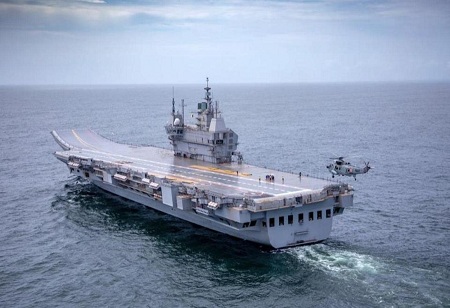Indigenous
Aircraft Carrier Vikrant which is the largest and most complex warship India has ever designed and built set off on its maiden sea trials on 4th August, 50 years after its namesake’s key role in the 1971 war. “With this Indigenous Aircraft Carrier, India will join a selected group of nations with the capability to indigenously design and built an aircraft carrier, which will be a real testimony to the
make-in-India campaign of the Indian Government,” said Navy’s spokesperson.
There is no doubt in the fact that an aircraft carrier is one of the most potent marine assets for a nation, that enhances a Navy’s capability to travel far from its home shores to carry out air domination operations. In 1999, the then Defence Minister George Fernandes authorised the development and construction of an aircraft carrier INS Carrier under the project 71 of Air Defence Ship (ADS). At that time, the Indian Navy needed a carrier that would be able to carry large number of jet fighters.
In the year 2001, CSL (Cochin Shipyard Limited) which is the largest shipbuilding and maintenance facility in India released a graphic illustration showing a 32,000 ton STOBAR (Short Take Off But Arrested Recovery) design. Then the Indian Government started thinking about it seriously and aircraft carrier project finally received formal government approval in January 2003.
By this time, the design team was thinking of a 37,500 tonnes carrier which can easily operate the MiG-29K. At that time country opted for a three carrier naval consisting of one carrier battle group stationed on each seaboard, and a third carrier held in reserve. This third carrier is there to continuously protect both its wings.
Changes that took place in Manufacturing
In August 2006, then Chief of the Naval Staff, Admiral Arun Prakash stated that the official designation for the vessel had been changed from ADS (Air Defence Ship) to IAC (Indigenous Aircraft Carrier. The name ADS had been adopted as a substitute during the stages when the vessels were planned.
Another change that happened was in the displacement of carrier from 37,500 tons to over 40,000 tons. Also, the length of the carrier increased from 252 metres to 262 metres.
Vikrant has been designed by keeping in mind that it can carry an air group of up to thirty aircrafts. This group of aircrafts will include up to 24-26 fixed wing combat aircraft, mainly Mikoyan MiG-29K, besides carrying 10 Kamov Ka-31 or Westland Sea King Helicopters. These aircrafts have certain roles like Ka-31 can fulfill the Airborne Early Warning (AEW) role and the Sea King provides Anti-Submarine Warfare (ASW) capability. It has the potential to offer an incomparable military instrument with these abilities.
Challenges that Came in the Way
The indigenous Aircraft Carrier Vikrant is considered as the first aircraft carrier which has been designed by the Directorate of Naval Design of the Indian Navy and the warship to be manufactured by Cochin Shipyard. Many private and public firms came together for its construction. At first it was decided to import A- grade steel from Russia but there were some problems occurring in its delivery.
Looking at this issue, Steel Authority of India Limited (SAIL) and Defence Metallurgical Research Laboratory (DMRL) which is a research laboratory of the Defence Research and Development Organisation (DRDO) based in Hyderabad came together and created facilities to manufacture the required quality of steel in India. The ship uses modular construction, with 874 blocks joined together for the null.
Reasons for Delay in Project
There have been many delays while manufacturing Indigenous Aircraft Carrier Vikrant. Earlier, looking at its construction plan, it was decided to be launched in the year 2010 by the officials. That time its displacement was around 20,000 tonnes as a large displacement could not be accommodated in the building bay. That time it was planned that after about a year’s development in the refit dock, the carrier would be launched when all the major components, including underwater systems, would be in place.
One of the many reasons behind the delay in the manufacturing of Vikrant was delay in delivery of the main gearboxes for the carrier. As the length of the propulsion shafts had been increased, the work of the supplier company Elecon Engineering had increased as it had to work on lot of complexities which resulted in the delay of the carrier. There were some issues related to the alignment of the carrier and an accident with a diesel generator which added the delays. Another reason for delay in carrier’s targeted delivery was delay in the supply of aviation equipment from Russia.
The Way Forward
Vikrant had completed its harbour trials in September 2020 and basin trials started in October 2020. The basin trials were done to check propulsion, electric transmission and shafting systems. Then on November 2020, the basin trials were completed , paving the way for sea trials which was the final phase of the Indigenous Aircraft Carrier Vikrant. Finally on 4the August, the sea trials finally began and the carrier is scheduled to be commissioned in August 2022 adding superior combat capability, range and versatility to the country’s naval might.
